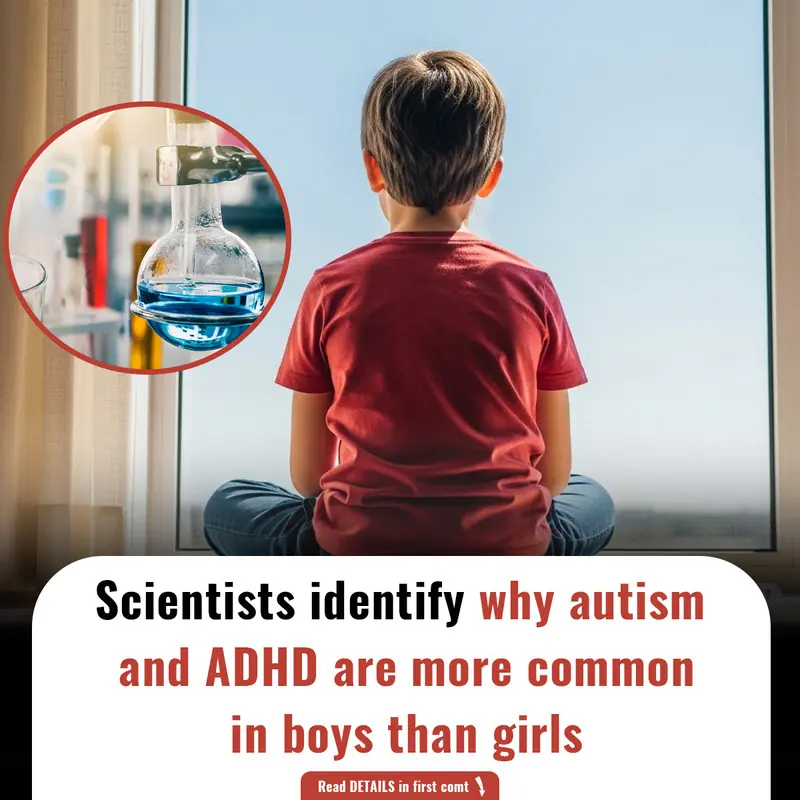Scientists may have uncovered a clue as to why boys are diagnosed with autism and ADHD at a rate three times higher than girls.

A research team from the University of Rochester has proposed that boys could be more susceptible to environmental toxins — especially long-lasting synthetic substances known as forever chemicals — during critical stages of brain development.
These chemicals, which have the potential to disrupt brain signaling pathways, may lead to behavioral issues like social withdrawal, hyperactivity, and difficulty with attention and instructions — patterns commonly observed in conditions like autism and ADHD.
Ubiquitous Chemicals with Lasting Impact
Forever chemicals, including PFAS (per- and polyfluoroalkyl substances), are found in an astonishing range of everyday items — from water bottles and clothing to food packaging and even tap water. These compounds degrade extremely slowly, sometimes taking centuries to break down, and have already been associated with cancer, reproductive issues, and developmental problems.
In this new study, researchers homed in on one particular PFAS chemical: PFHxA, frequently used in grease-proof paper and stain-resistant fabrics.
According to the study, PFHxA exposure appeared to trigger behaviors in male mice that mirror characteristics of ADHD and autism — but not in females.
The Experiment: A Closer Look
To assess its effects, the scientists administered PFHxA to mother mice during pregnancy and nursing. The substance was hidden in a mealworm treat, ensuring that the developing pups were exposed both before birth through the placenta, and after birth via the mother’s milk.
What followed was troubling: male offspring exhibited significant developmental issues — including reduced activity, heightened anxiety, and impaired memory — while female mice showed no such changes.
Even more alarmingly, these behavioral changes persisted long after initial exposure, indicating the effects might be long-term and possibly permanent.
Why Only Boys?
Lead author Professor Elizabeth Plunk, an environmental medicine specialist, called the findings “worrying.” Published in the European Journal of Neuroscience, the study noted that while the changes were relatively subtle, they were strikingly male-specific, resembling the gender disparity often observed in neurodevelopmental conditions.
“Understanding how PFHxA influences the developing brain is essential if we’re going to make informed decisions about regulating its use,” Prof. Plunk said.
The researchers now plan to expand their work, focusing on the brain regions associated with movement, emotion regulation, and memory — areas commonly affected in individuals with autism and ADHD.
A Broader Crisis?
These findings arrive amid increasing concerns about rising ADHD and autism rates.
The NHS reports that roughly 2.5 million people in England are currently living with ADHD, a condition that impairs focus, self-regulation, and behavior control. Common symptoms include fidgeting, forgetfulness, impulsive behavior, and difficulty managing tasks or schedules.
At the same time, autism diagnoses are surging, with around 200,000 people currently awaiting assessments across England. Autism spectrum disorder impacts how individuals perceive and engage with the world, often affecting social interactions, communication, and behavior patterns. According to the World Health Organization, about 1 in 100 children globally are on the autism spectrum.
Autism is not an illness and is present from birth, though signs may not become obvious until early childhood or even later in life.
Is It Just That Boys Are Diagnosed More Often?
Historically, autism and ADHD have been considered more prevalent in boys — but experts now suggest that part of the disparity could come down to diagnostic bias.
Boys are more likely to exhibit visible symptoms and be referred for evaluation, while girls may mask their difficulties by mimicking others, potentially delaying diagnosis.
The NHS highlights this diagnostic gap, noting that autistic girls often go undetected because they can better adapt to social situations, at least on the surface.
Still, researchers fear that chemical exposure could be aggravating the problem, with some experts warning earlier this year that the UK's regulations on PFAS chemicals remain insufficient.
A Regulatory Turning Point?
PFAS compounds are valued in industry for their resilience — but this very quality makes them persistent and hazardous in the environment.
A major review of 500 scientific studies published last year linked these substances to a host of serious health outcomes, from immune system suppression to increased cancer risks.
Now, the Environmental Audit Committee (EAC) is preparing to present its findings to the UK Government, including recommendations on whether tighter regulations on PFAS use are necessary.
As the evidence builds, scientists urge caution: environmental exposure, especially during early brain development, could be a major factor in the growing prevalence of neurodevelopmental disorders — and boys may be disproportionately at risk.




























